There are some birds that people love to hate, they aren’t liked for many reasons and some of those reasons may have valid foundations for their feelings. Some, not so much, maybe they just don’t like birds and the ones they hate symbolize those feelings.
Among “hated” birds there are the corvids that include crows, jays, and ravens.
 Fish Crow on the beach – Nikon D200, f7.1, 1/750, ISO 200, Nikkor 80-400mm VR at 400mm, natural light
Fish Crow on the beach – Nikon D200, f7.1, 1/750, ISO 200, Nikkor 80-400mm VR at 400mm, natural light
I know of one woman who hates Fish Crows because they do what they do and sometimes that means they predate on the chicks of Least Terns. Well, they were doing that long before humans moved into their habitat and forced the Least Terns into smaller and smaller nesting areas, which means the fact is, some of the blame falls directly on humans for concentrating the nesting areas of those terns.
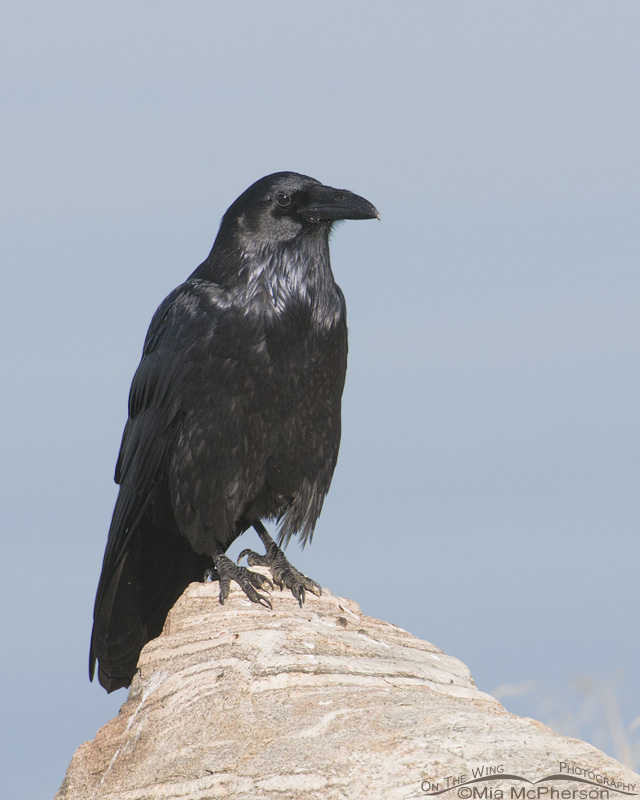 Common Raven adult on the causeway to Antelope Island – Nikon D300, f8, 1/1000, ISO 640, +0.7 EV, Nikkor 200-400mm VR with 1.4x TC at 400mm, natural light
Common Raven adult on the causeway to Antelope Island – Nikon D300, f8, 1/1000, ISO 640, +0.7 EV, Nikkor 200-400mm VR with 1.4x TC at 400mm, natural light
And some people don’t like Common Ravens much either. I know, they can be loud, they can swipe small items left around outside. But they are intelligent, curious birds. If you don’t want things swiped by the ravens maybe securing those things is a good idea.
Black birds kind of scare some people just like a black cat does when it crosses their path. Bah. That is nothing but silly superstition.
 Black-billed Magpie landing with nesting material – Nikon D200, f7.1, 1/2000, ISO 400, Nikkor 200-400mm VR at 400mm, natural light
Black-billed Magpie landing with nesting material – Nikon D200, f7.1, 1/2000, ISO 400, Nikkor 200-400mm VR at 400mm, natural light
I knew of someone who absolutely hated Black-billed Magpies for what seemed to be no reason at all but that guy was kind of hateful anyway.
Quite often people don’t like Black-billed Magpies because they are noisy and that is truthful.
Well, we humans aren’t so quiet either with our noisy vehicles, lawn mowers sputtering around to cut sterile, worthless lawns and all the man made contraptions that make our lives easier that intrude on the lives of the magpies.
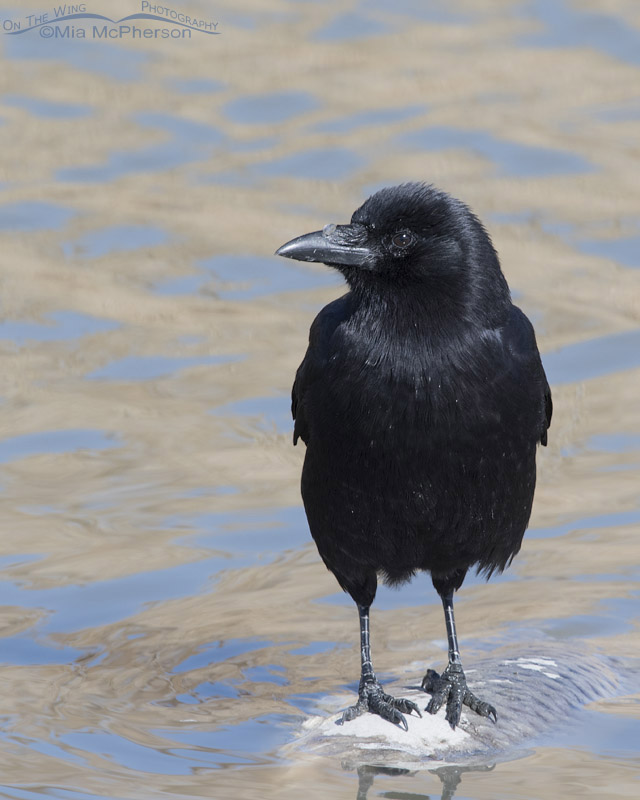 American Crow at Farmington Bay WMA – Nikon D500, f9, 1/640, ISO 400, +0.3 EV, Nikkor 500mm VR with 1.4x TC, natural light
American Crow at Farmington Bay WMA – Nikon D500, f9, 1/640, ISO 400, +0.3 EV, Nikkor 500mm VR with 1.4x TC, natural light
Here in Utah during the winter American Crows present problems because they poop where they roost in the hundreds or thousands and I get that, who wants poop all over their yard, house or car. It is unsanitary. Most of the American Crows overwinter here then in the spring they head to their breeding territories, we don’t have that many of them that breed here in Utah. I can’t hate them for doing what they were doing before people moved here, built here and intruded on their winter home.
And some people don’t like Blue Jays much either because they can also be very noisy. Sorry, I love hearing jays and don’t understand people who don’t.
Corvids are smart birds. I admire all of them for that.
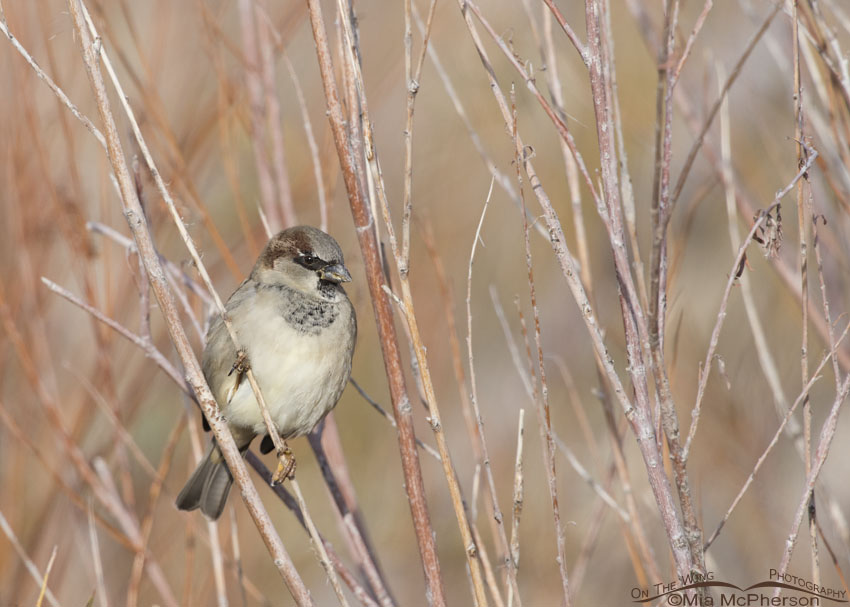 Male House Sparrow perched in a bush – Nikon D810, f7.1, 1/1250, ISO 400, Nikkor 500mm VR with 1.4x TC, natural light
Male House Sparrow perched in a bush – Nikon D810, f7.1, 1/1250, ISO 400, Nikkor 500mm VR with 1.4x TC, natural light
People hate House Sparrows because they are not native, invasive and they can out compete and even kill native birds. They are thought of as pests, and they can be, and are often called brown-winged rats. Somehow though I can’t blame these birds for being here because we silly humans are the ones that brought them here and let them go. Strangely enough their numbers are reported to be on the decline in their native lands.
I found an interesting article on House Sparrows at the Smithsonian website for those who are interested in reading it here.
 European Starling feeding on fruit – Nikon D200, f8, 1/500, ISO 250, +0.3 EV, Nikkor 200-400mm VR at 400mm, natural light
European Starling feeding on fruit – Nikon D200, f8, 1/500, ISO 250, +0.3 EV, Nikkor 200-400mm VR at 400mm, natural light
Despite the risk of repeating myself I am repeating myself: People hate European Starlings because they are not native, invasive and they can out compete and even kill native birds. Somehow though I can’t blame these birds for being here because we silly humans are the ones that brought them here and let them go.
I don’t like that these House Sparrows and European Starling kill our native birds and that they out compete them for food and nesting areas.
But… who is to blame? Hint, it isn’t the birds.
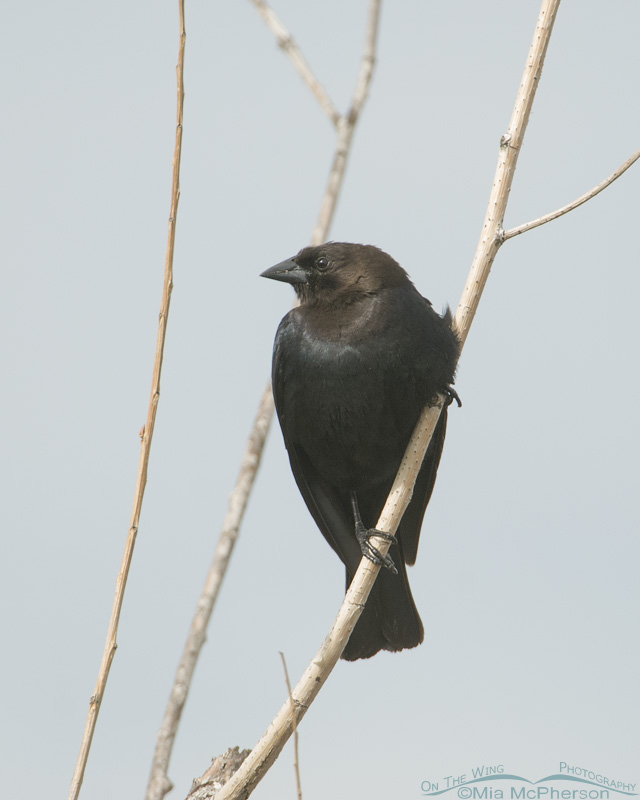 Perched male Brown-headed Cowbird – Nikon D200, f6.3, 1/640, ISO 400, +0.3 EV, Nikkor 200-400mm VR with 1.4x TC at 400mm, natural light
Perched male Brown-headed Cowbird – Nikon D200, f6.3, 1/640, ISO 400, +0.3 EV, Nikkor 200-400mm VR with 1.4x TC at 400mm, natural light
Native Brown-headed Cowbirds have bad reputations as brood parasites which means the female cowbirds lay their eggs in the nests of other birds and their young when hatched by the host species out compete their young which can mean fatalities of the host species chicks. That sounds grim and it is, especially since the cowbirds expanded their range to the east when they used to be primarily in the Great Plains. Some bird species in the east, for instance the Kirtland’s Warbler, are in decline because of habitat destruction and the expanded range of Brown-headed Cowbirds and cowbirds laying their eggs in the warbler’s nests.
These “Buffalo Birds” expanded their ranges in all directions during the 19th and 20th centuries during a time period when humans were cutting down the forests to the east, west, north and south of the Great Plains. Cowbirds typically avoid heavily forested areas but once those forests were chopped down and the lands that used to be forested became open fields, farm lands and residential areas it made it easier for these birds to expand their range.
Some of the birds here in the west have adapted to brood parasites and once they find a cowbird egg in their nest some even build a new nest right over top of the cowbird egg and lay more eggs of their own and the cowbird egg never hatches because it isn’t incubated.
I hate what is happening to the warblers because of the cowbird range expansion but again, where does the actual blame lay?
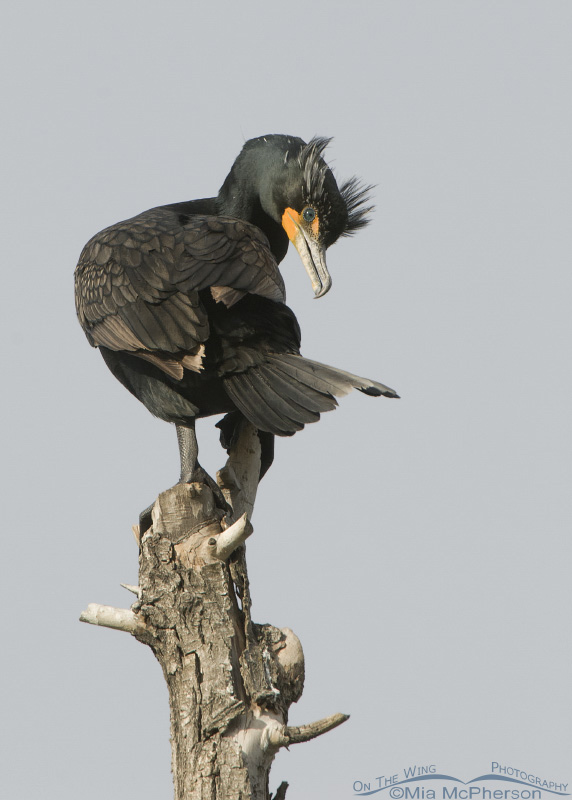 Adult Double-crested Cormorant – Nikon D200, f10, 1/350, , ISO 320, +1.0 EV, Nikkor 200-400mm VR with 1.4x TC at 400mm, natural light
Adult Double-crested Cormorant – Nikon D200, f10, 1/350, , ISO 320, +1.0 EV, Nikkor 200-400mm VR with 1.4x TC at 400mm, natural light
Some folks hate Double-crested Cormorants because they eat fish. Both commercial fish farmers and some recreational fisher-people hate that the cormorants catch and consume fish. I used to listen to one person complain, time and time again ad nauseum, about how the cormorants were stealing his fish when he saw them out on the lakes he fished in. Well, guess what, they aren’t your fish unless you bought the land the pond or lake is on plus bought and stocked all of the fish. If you did put a roof on it so the cormorants can’t get in. You could also growl at any other fisher-person for stealing your fish too. Get over it, they aren’t your fish if you didn’t buy them.
And please don’t hate them because they are excellent at catching fish.
Did you know that some people hate American White & Brown Pelicans for eating fish too?
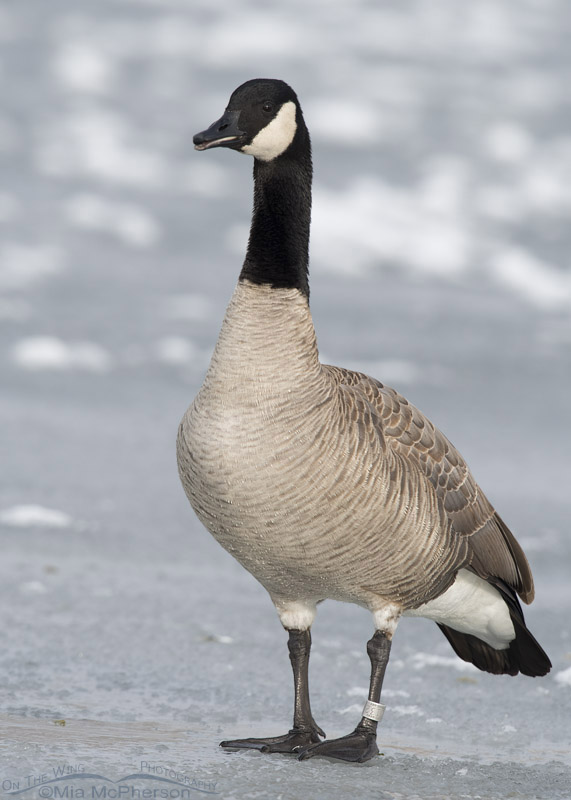 Canada Goose on ice – Nikon D500, f7.1, 1/640, ISO 400, +0.3 EV, Nikkor 500mm VR with 1.4x TC, natural light
Canada Goose on ice – Nikon D500, f7.1, 1/640, ISO 400, +0.3 EV, Nikkor 500mm VR with 1.4x TC, natural light
Some people hate Canada Geese because they are so common, can be very loud, can be aggressive, and they poop a lot which messes with those nice, green but sterile grassy areas around city parks, golf courses, and lawns. They can also cause problems near air ports because of collisions with airplanes, I understand that.
Me, I don’t mind them one little bit. I love to hear them and I know enough to stay away from them when they have goslings because they are far more aggressive when they have young and even though it bothers me to have goose poop on my shoes I have to admire how that same poop works as a great fertilizer for those grassy areas and I’d rather have goose poop on my shoes than dog poop.
 Drake Mallard on a cold December day – Nikon D200, f8, 1/640, ISO 320, Nikkor 200-400mm VR with 1.4x TC at 400mm, natural light
Drake Mallard on a cold December day – Nikon D200, f8, 1/640, ISO 320, Nikkor 200-400mm VR with 1.4x TC at 400mm, natural light
Pretty much everything I wrote about why some people hate Canada Geese applies to Mallards. They are our most common duck in North America. Mallards aren’t as nearly as terrifying when they chase after you because you are too close to their ducklings because they aren’t as large as Canada Geese.
 Laughing Gull at fountain – Nikon D200, f6.3, 1/1500, ISO 250, Nikkor 80-400mm VR at 400mm, natural light
Laughing Gull at fountain – Nikon D200, f6.3, 1/1500, ISO 250, Nikkor 80-400mm VR at 400mm, natural light
I would be remiss if I didn’t mention gulls as birds people love to hate because so many people do. I don’t, won’t, and will not ever hate these birds. They are called “flying rats” and are hated because they poop on things, steal food, can be loud, and scare some people enough that they dive for cover around gulls. I’m certain the movie “The Birds” didn’t help when it comes to gulls.
But the gulls are just doing what comes naturally to them and if you put food out on a picnic table they will seize the opportunity to grab that food if it is uncovered and unattended. The same goes for our uncovered municipal waste facilities which they see it as a giant smorgasbord. They are quite naturally opportunists.
Okay, that is enough for now, there are more birds that people love to hate but I can only deal with so much of it before I feel the need to get out and photograph all the birds I see, even those that other people despise. There is enough hate in the world already.
Life is good. Birds are good.
Mia
Click here to see more of my bird photos in their galleries.


I have a hard time hating any bird even “trash birds”! All of these can be beautiful in the sunlight and do serve a purpose. I really wish we could get rid of the “Trash people” who trash God’s creation!
I love this post and all the beautiful pictures. Thank you!!!!
Well, I gotta tell you…cowbirds ain’t my favorite either. I can’t think of any other bird species I dislike at all…but cowbirds are the exception.
This series of pics – combined with your narrative – is absolutely terrific. I especially like the starling image. Thanks Mia.
Your blog is ALWAYS amazing and one of the few I read every day. This entry was magnificent! You may want to consider the book Mozart’s Starling by Lyanda Lynn Haut. I think you might really enjoy it. Thank you for sharing your work so generously.
Hating birds? Sigh.
Not people I want to spend any time with.
And you are very right about where the ‘blame’ lies.
EACH ONE OF THESE IS SO DARNED BEAUTIFUL I FEEL OVERWHELMED BY THEM!!!! Having had a crow pest/friend , they come first, butvALL are fantastic…starting with the guy on the beach…..GREAT!!!
Lovely photos, and lovely birds, all of them!
Thank you for this particular lesson in birds. I have experienced some of them, couldn’t identify others but am grateful to have them around me. Kentucky has many birds and I enjoy them all. You have brought information to me that increases my joy. Thank you Mia.
I say these same things all the time when people complain. Love your commentary. Love the photo of the cormorant, too!! Thanks, Mia
Great post! I’ve at one time or another heard all those ‘complaints’. I guess beauty is in the eyes of the beholder…I find them all beautiful. They are only doing what is natural for them…just as we probably annoy others by doing what is natural for us!
Wow, I know bird haters. At our old house we had a large pond and the starlings, robins, waxwings, etc would all bathe in harmony. You are so correct Mia, man is to blame and the birds are just doing what nature dictates. They all have their place…even man.
HAH! Love your commentary…yes these “problems” ultimately were caused by US!
We think we own the place…well guess what…the birds were here FIRST!
Wow, you are really wound up today. I agree with you……how can a person hate birds? Although, I will admit to being annoyed by Canada Geese occasionally calling in the middle of the night on the creek in front of my house. Fish crows…..I was so excited to hear 3 of them back this week.